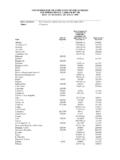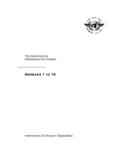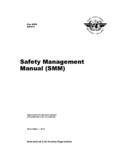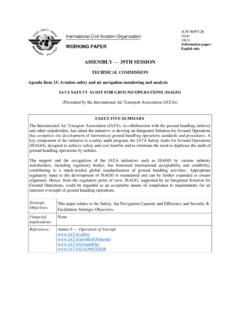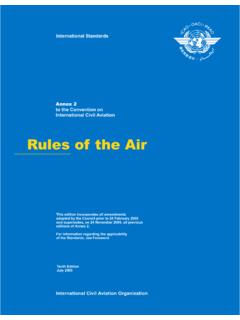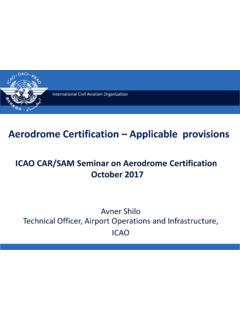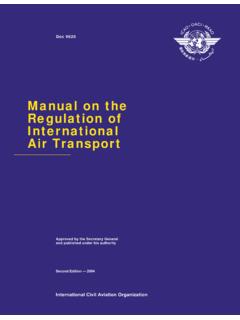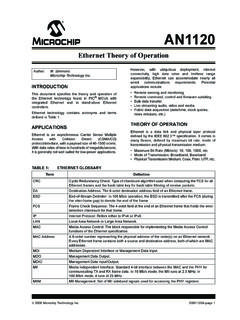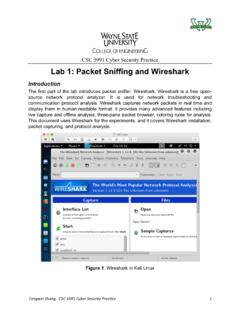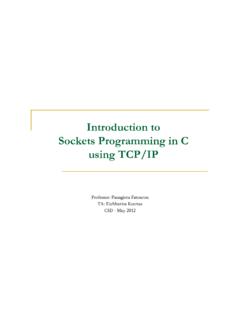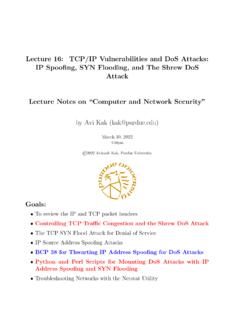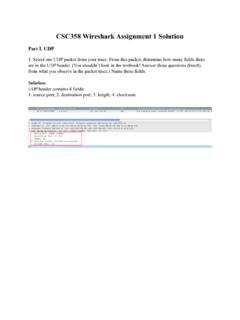Transcription of 14. TCP/IP Protocol Suite - ICAO
1 11/10/2010114. TCP/IP Protocol SuiteContentsa. TCP/IP Internet OSIb. Network level IP protocolc. Addressing and sub-networksd. Other network-level protocolseTransport level11/10/20102a. TCP/IP Internet OSIb. Network level IP Protocol 11/10/20103 Position of IPv4 in TCP/IP Protocol suiteIPv4 datagram format11/10/20104 Service type or differentiated servicesThe precedence subfield was part of version 4, but never of serviceDefault types of service11/10/20106 Values for codepointsThe total length field defines the total length of the datagram including the of a small datagram in an Ethernet frameProtocol field and encapsulated data11/10/20108 Protocol valuesAn IPv4 packet has arrived with the first 8 bits as shown:01000010 ThididthktWh ?Example 1 Thereceiverdiscardsthe is an error in this packet. The 4 leftmost bits (0100) show the version, which is correct.
2 The next 4 bits (0010) show an invalid header length (2 4 = 8). The minimum number of bytes in the header must be 20. The packet has been corrupted in an IPv4 packet, the value of HLEN is 1000 in many bytes of options are being carried by thispacket?Example 2 SolutionThe HLEN value is 8, which means the total number ofbytes in the header is 8 4, or 32 ,thenext12bytes are the an IPv4 packet, the value of HLEN is 5, and the valueof the total length field is 0x0028. How many bytes ofdata are being carried by this packet?Example 3 SolutionThe HLEN value is 5, which means the total number ofbytes in the header is 5 4, or 20 bytes (no options)Thetotallengthis40byteswhichmean sthepacketisThetotallengthis40bytes,whic hmeansthepacketiscarrying 20 bytes of data (40 20).11/10/201010An IPv4 packet has arrived with the first few hexadecimal digits as.
3 Example 4 How many hops can this packet travel before beingdropped? The data belong to what upper-layer Protocol ?SolutionTo find the time-to-live field, we skip 8 , means the packet can travel only one Protocol field is the next byte (02), which meansthat the upper-layer Protocol is transfer unit (MTU)11/10/201011 MTUs for some networksFlags used in fragmentation11/10/201012 Fragmentation exampleDetailed fragmentation example11/10/201013A packet has arrived with an M bit value of 0. Is this thefirst fragment, the last fragment, or a middle fragment?Dkifthktftd?Example 5 Doweknowifthe packetwasfragmented?SolutionIf the M bit is 0, it means that there are no morefragments; the fragment is the last , we cannot say ifthe original packet wasfragmented or non-fragmented packet is considered the packet has arrived with an M bit value of 1.
4 Is this thefirst fragment, the last fragment, or a middle fragment?Do we know if the packet was fragmented?Example 6 SolutionIf the M bit is 1, it means that there is at least one fragment can be the first one or a middle one, don t know if it is the first one or a middle one; weneed more information (thevalue of the fragmentationoffset).11/10/201014A packet has arrived with an M bit value of 1 and afragmentation offset value of 0. Is this the first fragment,the last fragment, or a middle fragment?Example 7 SolutionBecause the M bit is 1, it is either the first fragment or amiddle the offset value is 0, it is packet has arrived in which the offset value is is the number of the first byte? Do we know thenumber of the last byte?Example 8 SolutionTo find the number of the first byte, we multiply the offset value by 8.
5 FThis means that the first byte number is cannot determine the number of the last byte unless we know the packet has arrived in which the offset value is 100, thevalue of HLEN is 5, and the value of the total length fieldis 100. What are the numbers of the first byte and theExample 9last byte?SolutionThe first byte number is 100 8 = 800. The total length is 100 bytes, and the header length is 20 b(54)hi hhh80 bi20 bytes (5 4), which means that there are 80 bytes in this datagram. If the first byte number is 800, the last byte number must be Addressing and sub-networks11/10/201016An IPv4 address is 32 bits IPv4 addresses are unique and notation and binary notation for an IPv4 addressNumbering systems are reviewed in Appendix the following IPv4 addresses from binarynotation to dotted-decimal 1 SolutionWe replace each group of 8 bits with its equivalentdecimal number(seeAppendix B)and add dots for(pp) the following IPv4 addresses from dotted-decimal notation to binary 2 SolutionWe replace each decimal number with its binaryequivalent11/10/201019 Find the error, if any, in the following IPv4 3 Solutiona.
6 There must be no leading zero (045).b. There can be no more than four Each number needs to be less than or equal to A mixture of binary notation and dotted-decimalnotation is not classful addressing, the address space is divided into five classes:A, B, C, D, and the classes in binary and dotted-decimal notationFind the class of each 00000001 00001011 00001011 11101111b. 11000001 10000011 0001101111111111 Example 4c. The first bit is 0. This is a class A Cb. The first 2 bits are 1; the third bit is 0. This is a class C The first byte is 14; the class is The first byte is 252; the class is of blocks and block size in classful IPv4 addressingIn classful addressing, a large part of the available addresses were masks for classful addressingClassful addressing, which is almost obsolete, is replaced with classless following figure shows a block of addresses, in bothbinary and dotted-decimal notation, granted to a smallbusiness that needs 16 5We can see that the restrictions are applied to this addresses are number of addresses is a power of 2 (16 = 24)
7 , andthe first address is divisible by ,whenconvertedtoadecimalnumber,is 3,440,387,360, which when divided by 16 results in215,024, block of 16 addresses granted to a small organization11/10/201024In IPv4 addressing, a block of addresses can be defined /nin which x y z t defines one of thein which defines one of the addresses and the /ndefines the first address in the block can be found by setting the rightmost 32 nbits to block of addresses is granted to a small know that one of the addresses is is the first address in the block?Example 6 SolutionThe binary representation of the given address is11001101 00010000 00100101 00100111If we set 32 28 rightmost bits to 0, we get 11001101 00010000 00100101 0010000 or is actually the block shown in last address in the block can be found by setting the rightmost 32 n bits to the last address for the block in Example 7 The binary representation of the given address is11001101 00010000 00100101 00100111If we set 32 28 rightmost bits to 1, we get 11001101 00010000 00100101 00101111 or is actually the block shown in and addresses in a subnetted network11/10/201027 Three-level hierarchy in an IPv4 addressAn ISP is granted a block of addresses starting (65,536 addresses).
8 The ISP needs todistribute these addresses to 3 groups of customersExampleas follows:a. The first group has 64 customers; each needs The second group has 128 customers; each needs128 The thirdgrouphas 128 customers;each needs 64gp; the subblocks and find out how many addressesare still available after these shows the 1 For this group, each customer needs 256 means that 8 (log2 256) bits are needed to defineeach host. The prefix length is then 32 8 = 24. Theaddresses areExampleGroup 2 For this group, each customer needs 128 t7(l2128)bitddtdfiThis meansthat7(log2128)bits are neededtodefineeach host. The prefix length is then 32 7 = 25. Theaddresses are11/10/201029 ExampleGroup 3 For this group, each customer needs 64 addresses. Thismeans that 6 (log264) bits are needed to each host. Theprefixlengthisthen32 6=26 Theaddressesare:prefixlengthisthen32 6= :Number of granted addresses to the ISP: 65,536 Number of allocated addresses by the ISP: 40,960 Number of available addresses: 24,576An example of address allocation and distribution by an ISP11/10/201030 Tbl Addfi ttkTable.
9 Addresses for private networksA NAT implementation11/10/201031 Addresses in a NATNAT address translation11/10/201032 Table. Five-column translation tabled. Other network-level protocols 11/10/201033 Position of UDP, TCP, and SCTP in TCP/IP suiteARP and RARP11/10/201034 ARP operationARP packet11/10/201035 Encapsulation of ARP packetFour cases using ARP11/10/201036A host with IP address and physicaladdress B2:34:55:10:22:10 has a packet to send toanother host with IP address and physicalExampleaddress A4:6E:F4:59:83:AB. The two hosts are on thesame Ethernet network. Show the ARP request and replypackets encapsulated in Ethernet Note that the ARP data field in this case is 28bytes, and that the individual addresses do not fit in the4-byte boundary. That is why we do not show the regular4-byte boundaries for these An ARP request and reply11/10/201037 Proxy ARPRARP operation11/10/201038 RARP packetEncapsulation of RARP packet11/10/201039 BOOTP client and server on the same and different networksGeneral format of ICMP messages11/10/201040 Error-reporting messagesRedirection concept11/10/201041 Query messagesIGMP message types11/10/201042 IGMP message formatIGMP type field11/10/201043 IGMP operationImagine there are three hosts in a network, as shown inthe following query message was received at time 0; the randomExampledelay time (in tenths of seconds) foreach group isshown next to the group the sequence of report :Theeventsoccurinthissequence:a.
10 Time 12:The timer for in host A expires,and a membership report is sent, which is receivedby the router and every host including host B whichcancels its timer for Time 30:The timer for in host A expires, and a membership report is sent which is received by the router and every host including host C which l it tif225 14 0 0cancels its timer for Time 50:The timer for in host B expires,and a membership report is sent, which is receivedby the router and every Time 70:The in host C expires,and a membership report is sent, which is receivedby the router and every host including host A whichcancels its timer for Transport levelThe transport layer is responsible for process-to-process of data deliveriesPort numbers11/10/201047IP addresses versus port numbersIANA ranges11/10/201048 Socket addressMultiplexing and demultiplexing11/10/201049 Error controlPosition of UDP, TCP.
